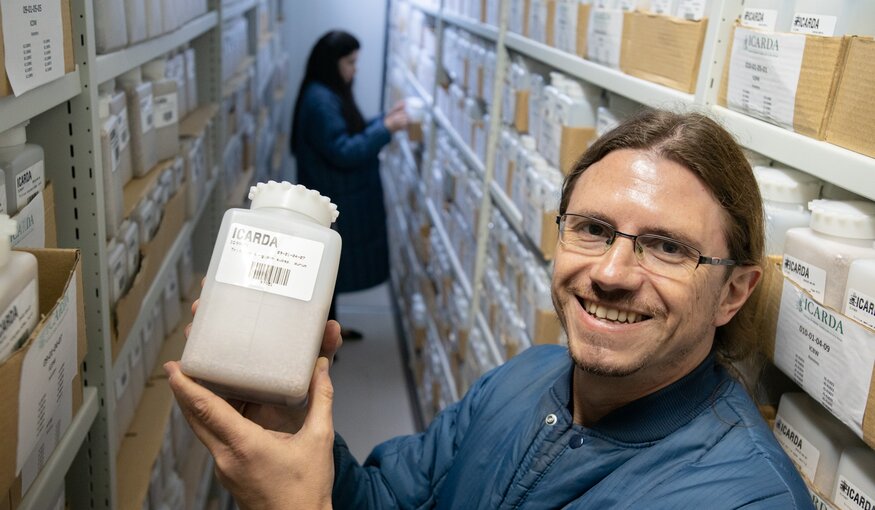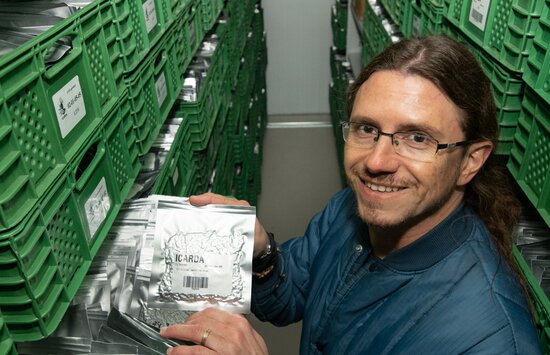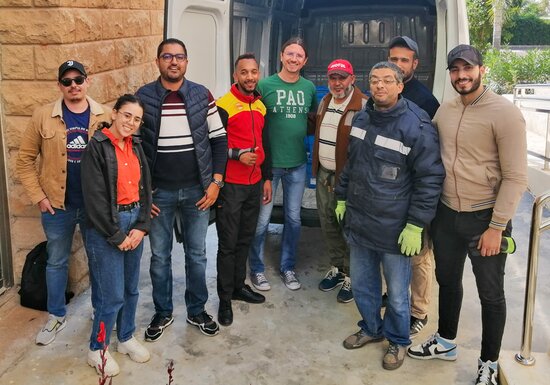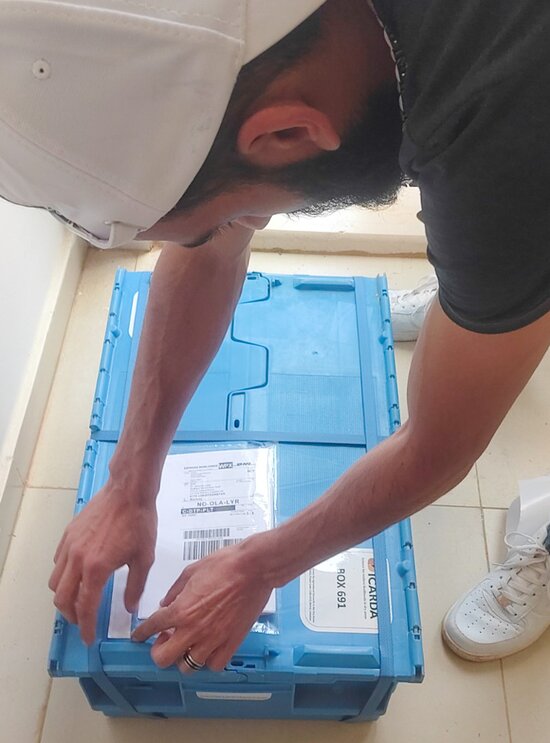Safeguarding Ethiopian Wheat and Other Centuries-old Landraces in Svalbard

ICARDA Genebank Manager Athanasios Tsivelikas in active collection cold room, Rabat, Morocco. Photo: Michael Major/Crop Trust
13 June 2023
Last week, the International Center for Agricultural Research in the Dry Areas (ICARDA) deposited seeds of traditional landraces of durum wheat, wild lentil and other crops on the frozen shelves in the depths of the Svalbard Global Seed Vault.
We chatted to Thanos Tsivelikas, ICARDA’s Genebank Manager in Morocco, who has been personally committed to restoring the seed samples that ICARDA was forced to withdraw from the Seed Vault after it had lost access to its primary genebank when war broke out in Syria in 2011.
Crop Trust: You’re the curator of a fantastic genebank collection and many of the varieties you safeguard are now extinct or endangered in their natural habitats. Do you ever get the chance to talk about your work with kids? How do you explain what you do to them?
Thanos Tsivelikas: Children are the future custodians of agrobiodiversity. I enjoy it when schools visit the ICARDA genebank, and we get to show children the beauty and importance of biodiversity. We give them the chance to see, touch and feel the diversity of our seeds, in size, color, shape and texture. They enjoy listening to stories of how their grandparents were using these landraces at events such as weddings, and how the first collectors gathered such seeds from all the five continents. At our Seed Quality Laboratory, they get the chance to bake bread from different landraces, to taste it and have their own competition for the landrace that produces the tastiest bread.
What kind of seeds do the 32 boxes that ICARDA sent to Svalbard contain?
The seeds that we deposited last week mostly originated in the heartland where crop domestication first occurred some 14,000 years ago: The Fertile Crescent. They represent a wide range of staple foods: seeds of bread and durum wheat, chickpea, lentil and faba bean.
We’ve packed seeds of crops which can be consumed by humans and as feed for livestock, such as barley and grasspea and forage species. We also deposited boxes containing the wild relatives of chickpea and lentil and other plants that can offer useful genes for adapting crops to harsh environments.
This is not your first rodeo. What is special about this deposit?
No, it is not! We have sent seeds to Svalbard 17 times. This time, what’s particularly exciting is that we sent a unique type of durum wheat that can be found in Ethiopia: Triticum aethiopicum, or Ethiopian wheat.
A large part of the samples that we deposited are traditional landraces that are tightly linked with the farming practices, cultural heritage and specific needs of local communities. Many of them can be traced back to the early 1900s, such as the durum wheat landrace “Belagatch”, which was collected from the steppes of Kazakhstan in 1908… Or the durum wheat landrace from the Girgeh region in Egypt collected in 1901. Others were collected from isolated communities, located in particularly inaccessible areas, such as the chickpea “Shuroobod” collected from the mountainous area of Hairkoron in Tajikistan, close to the border with Afghanistan.
How do you select the samples that would be backed-up in Svalbard?
We aim to have a full copy of our collection safety duplicated there. That’s our main goal.
After we moved the collection from Syria to Morocco and Lebanon, to build it back, we made three successive withdrawals: in 2015, 2017 and 2019, we retrieved a total of 116,475 samples from the Seed Vault. But I’m happy to say that in less than seven years we have managed to regenerate and send back a large portion of the seeds we retrieved.
Many of these samples, however, need special treatment during regeneration, since we do not want to risk anything in terms of their genetic integrity. Thus, we need isolation cages for some crops to avoid contamination, and we introduce bumblebee hives for others for better pollination, and we use special techniques to avoid seed dormancy. For this reason, some samples still do not have enough seeds to flag them in our database as ready for deposit at the Seed Vault.
We expect that in the next two years all of the samples we withdrew will have been sufficiently regenerated so we can send them back to the Seed Vault.
How much of your material is already backed up in Svalbard?
The ICARDA genebank holds 152,305 samples. Of those, 113,379 samples, or 74.4% of the entire collection, are safely duplicated at the Seed Vault as of last week. But this varies depending on the crop. So, for barley more than 95% of the collection is safely duplicated in the Seed Vault, while for wheat it’s 90%. For some other crops that need special treatment during regeneration, the percentage is lower. But as I said, we’re working on that!
The ICARDA genebank has been safety duplicating seeds at Svalbard since the Seed Vault opened. Tell us about the challenges the genebank faces in backing up its collection?
Our main challenge is to ensure we apply the best genebank standards to everything we do. Before sending any seeds to the Seed Vault we need to ensure that we have enough seeds of high quality. That’s not an easy task. The ICARDA genebank is taking the necessary precautions to produce high quality seeds for all of the samples that we maintain.
Why is crop diversity important? Why must it be conserved and made available?
Crop diversity links the past with the present and provides a vision for our future. It is a unique source of new traits that can provide resilience in modern crops so they can tackle both current and future agricultural challenges. Under no circumstances should we jeopardize it. For this reason, I believe that it’s imperative for the custodians of crop diversity to ensure the appropriate conditions for its conservation and use.
Lastly, how do you personally feel knowing that more ICARDA diversity is now safely backed up inside the Seed Vault?
I feel privileged to work at the ICARDA genebank and to be a custodian of agrobiodiversity. I feel deeply grateful to my colleagues who worked in Syria and initially set up our genebank. Thanks to their proactiveness and collaborative spirit, today we have these precious genetic resources back in our fields, and they are thriving and will be safely stored at our new ICARDA genebanks in Morocco and Lebanon and then be sent again for safety duplication at the Seed Vault.
The regeneration and duplication process is still ongoing for some of the samples, and this gives me some stress. My colleagues and I are very aware of the responsibility we carry at ICARDA. But I firmly believe that soon our entire collection will be safely backed up inside the Seed Vault. When that day comes, I can assure you that I will glow with happiness because our partnership will have fully implemented its commitment for securing crop diversity for the future generations.
Category: Svalbard Global Seed Vault



